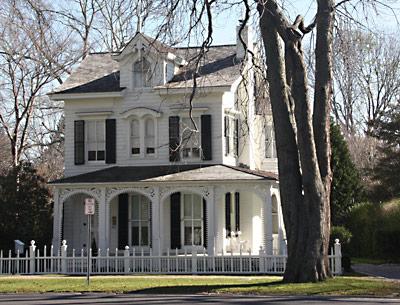Ye Olde Main Has a New Guide

Its glossy, heavy stock and appealing, even sexy, Hollywood set-worthy pictures may have some mistaking the Main Street Historic District Guide for a more commercial endeavor.
Although one section of Main Street is devoted to transient high-end consumerism, this booklet, produced by East Hampton Village and the East Hampton Historical Society, is a paean to Main Street’s permanence. Paid for by grants from the National Park Service and the state’s historic preservation offices as well as the historical society, the guide commemorates the tradition of preservation in the village and its more formalized efforts with the creation of historic districts.
The Main Street District, formed 25 years ago, stretches from Woods Lane to Huntting Lane. The guide highlights buildings that have been placed under public or nonprofit stewardship and residences still in private hands. These houses have had renovations or additions that have been completed since the historic district was established. The guide’s illustrations show how houses can be brought up to modern standards, the addition of pools and decks included, while still maintaining the traditional appearance of the streetscape.
“We wanted to show how you can have a modern life in a historic building,” said Robert Hefner, the director of historic services for the village and the co-author of the booklet. In the quarter-century that the district has been in existence, there have been 150 projects approved. Only 18 properties out of 75 have remained unchanged, Mr. Hefner said. Yet, the streetscape remains consistent.
According to Mr. Hefner, the applicants have been understanding. “Those who are attracted to Main Street are aware of the history and want to be part of that. They’ve tried hard to do the right thing.”
The population of East Hampton continues to change. Mr. Hefner said that the book, which was sent to every village household and has been given to village inns for visitors, is an educational tool. “People who live here are no longer growing up in East Hampton and knowing its history.”
The guide comes at a good time. The historical society, which has had a walking-tour pamphlet for many years, just ran out of copies. That tour is now included in the guide, with thumbnail full-color illustrations next to each description.
Richard Barons, the historical society’s director and the guide’s other author, said the tour would soon become a cellphone app as well, with additional text and photos.
Mr. Barons said that buildings we now take for granted — the windmills, Mulford Farm, and Home, Sweet Home, for instance — were all in peril at different times, and had it not been for the efforts of individuals and groups like the Ladies Village Improvement Society, they might all exist only in the 19th and early-20th-century prints and paintings made of them by artists such as the Morans and Childe Hassam.
A painting by Thomas Moran of his house in East Hampton, called the Studio, and a photograph from when he lived here are included in the guide. The house is now being restored to the way it was when he lived in it. Mr. Hefner said the painting was included as a reminder of the artistic heritage of Main Street and the inspirational qualities that have attracted artists to it over the centuries.
The simple saltbox structure at the Mulford Farm is one the earliest surviving homesteads in the village and the country. While many families visit the “old country” of their ancestors, here, Scottish Mulfords of recent vintage came to visit the new land of their 17th-century ancestors this fall.
Mr. Barons showed the visitors around and told them of the background and history of several buildings and objects associated with the family. These included a high chest recently acquired by the historical society that was made in Connecticut and purchased by the Mulfords during the time they spent there during the Revolutionary War.
The family members were thrilled to see the houses and objects associated with the Mulfords and how they had been preserved by a caring community, Mr. Barons said.
The Main Street guide includes interior photographs such as those above, of the frame of the Pantigo Windmill, left, and the ceiling of the living room of the J. Harper Poor Cottage, now known as the Baker House 1650.
